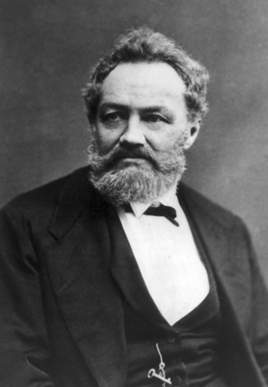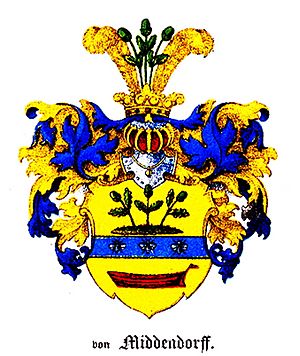Alexander von Middendorff facts for kids
Quick facts for kids
Alexander von Middendorff
|
|
|---|---|

von Middendorff circa 1880
|
|
| Born | 18 August [O.S. 6] 1815 |
| Died | 24 January [O.S. 12] 1894 (aged 78) Hellenorm Manor, Hellenorm, Kreis Dorpat, Governorate of Livonia, Russian Empire
(present-day Hellenurme, Valga County, Estonia) |
| Resting place | Hellenorm Manor Cemetery, Governorate of Estonia (in present-day Hellenurme, Estonia) |
| Nationality | Baltic German |
| Citizenship | Russian Empire German Confederation German Empire |
| Education | Humboldt University of Berlin University of Erlangen-Nuremberg University of Vienna University of Breslau |
| Alma mater | Imperial University of Dorpat |
| Occupation | Zoologist Explorer |
| Employer | Kiev University St Petersburg Academy of Sciences |
Alexander Theodor von Middendorff (born August 18, 1815 – died January 24, 1894) was a famous zoologist and explorer. He was of Baltic German and Estonian background. Middendorff made many important trips and discoveries, especially in the cold northern and eastern parts of Siberia. He studied animals, plants, and the effects of permafrost on nature.
Contents
Early Life and Family
Alexander Middendorff was born in Saint Petersburg, which was then part of the Russian Empire. His mother, Sophia Johanson, was the daughter of an Estonian farmer. She went to St. Petersburg for her education. There, she met Theodor Johann von Middendorff, who would later become a director at the St. Petersburg Pedagogical Institute.
Alexander and his older sister Anette were born before their parents officially married. This was not common at the time. To avoid public attention, his mother and Alexander moved back to Estonia. They lived at the Pööravere Mansion. When Alexander was ready for school in 1824, his parents finally got married. This made his status official.
Education and Early Career
Alexander Middendorff started his schooling with private teachers in Reval. He later attended a gymnasium in Saint Petersburg. In 1832, he began studying medicine at the Imperial University of Dorpat. He learned from many important professors there.
In 1837, he finished his medical degree. His final paper was about polyps in the bronchi. After that, he continued his studies at several other famous universities. These included the Humboldt University of Berlin and the University of Vienna. In 1839, he became an Assistant Professor of Zoology at Kiev University.
Exploring and Scientific Discoveries
Alexander Middendorff was a very active explorer and scientist. He loved to travel and study nature.
Expeditions to the North
In 1840, a scientist named Karl Ernst von Baer asked Middendorff to join him on an expedition. They planned to go to Novaya Zemlya, a group of islands in the Arctic Ocean. Bad weather stopped them from reaching Novaya Zemlya.
Instead, they explored Russian and Norwegian Lapland. They also studied the Barents Sea and White Sea. Middendorff had a special task. He walked across the Kola Peninsula, mapping the area and collecting samples. He gathered many different types of animals and plants.
Journey to Siberia and Beyond
Middendorff's most famous journey was from 1843 to 1845. He traveled for the St Petersburg Academy of Sciences. He went to the Taymyr Peninsula, a very cold region in northern Siberia. Then, he explored along the coast of the Sea of Okhotsk. He even went into the lower Amur River valley. This area was part of China at that time.
He wrote a huge book about his discoveries called Reise in den äußersten Norden und Osten Sibiriens. This means "Travels in the extreme north and east of Siberia." In this book, he explained how permafrost affects where animals and plants can live. Permafrost is ground that stays frozen all year round.
Middendorff also wrote about bird migration in Russia. He published a book called Die Isepiptesen Russlands in 1855. He also studied molluscs, which are soft-bodied animals like snails and clams. In his book Beiträge zu einer Malacozoologia Rossica, he even created a new scientific word: "radula". A radula is a special tongue-like organ that molluscs use to feed.
Later in his life, he visited other places. In 1870, he explored the Baraba steppe. In 1878, he went to the Fergana Valley.
Legacy and Namesakes
Alexander Middendorff passed away in 1894 in Hellenurme, Estonia. Many things have been named after him to honor his work. These include:
- Middendorff's grasshopper warbler, a type of bird.
- Cape Middendorff in Novaya Zemlya.
- The Kodiak bear (Ursus arctos middendorffi), a very large type of brown bear.
- Middendorff Bay on the Taymyr Peninsula.
Images for kids
See also
 In Spanish: Alexander Theodor von Middendorff para niños
In Spanish: Alexander Theodor von Middendorff para niños



